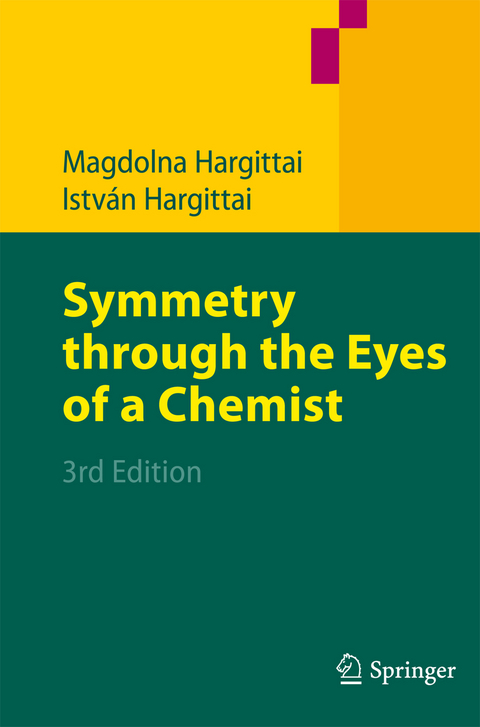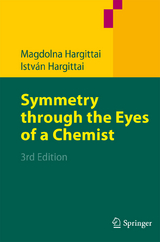Symmetry through the Eyes of a Chemist
Seiten
2009
|
3rd ed. 2009
Springer-Verlag New York Inc.
978-1-4020-5627-7 (ISBN)
Springer-Verlag New York Inc.
978-1-4020-5627-7 (ISBN)
Following the Int- duction (Chapter 1), Chapter 2 presents the simplest symmetries using chemical and non-chemical examples. The next four chapters present gro- theoretical methods (Chapter 4) and, based on them, discussions of molecular vibrations (Chapter 5), electronic structures (Chapter 6), and chemical reactions (Chapter 7).
It is gratifying to launch the third edition of our book. Its coming to life testi?es about the task it has ful?lled in the service of the com- nity of chemical research and learning. As we noted in the Prefaces to the ?rst and second editions, our book surveys chemistry from the point of view of symmetry. We present many examples from ch- istry as well as from other ?elds to emphasize the unifying nature of the symmetry concept. Our aim has been to provide aesthetic pl- sure in addition to learning experience. In our ?rst Preface we paid tribute to two books in particular from which we learned a great deal; they have in?uenced signi?cantly our approach to the subject matter of our book. They are Weyl’s classic, Symmetry, and Shubnikov and Koptsik’s Symmetry in Science and Art. The structure of our book has not changed. Following the Int- duction (Chapter 1), Chapter 2 presents the simplest symmetries using chemical and non-chemical examples. Molecular geometry is discussed in Chapter3. The next four chapters present gro- theoretical methods (Chapter 4) and, based on them, discussions of molecular vibrations (Chapter 5), electronic structures (Chapter 6), and chemical reactions (Chapter 7). For the last two chapters we return to a qualitative treatment and introduce space-group sym- tries (Chapter 8), concluding with crystal structures (Chapter 9). For the third edition we have further revised and streamlined our text and renewed the illustrative material.
It is gratifying to launch the third edition of our book. Its coming to life testi?es about the task it has ful?lled in the service of the com- nity of chemical research and learning. As we noted in the Prefaces to the ?rst and second editions, our book surveys chemistry from the point of view of symmetry. We present many examples from ch- istry as well as from other ?elds to emphasize the unifying nature of the symmetry concept. Our aim has been to provide aesthetic pl- sure in addition to learning experience. In our ?rst Preface we paid tribute to two books in particular from which we learned a great deal; they have in?uenced signi?cantly our approach to the subject matter of our book. They are Weyl’s classic, Symmetry, and Shubnikov and Koptsik’s Symmetry in Science and Art. The structure of our book has not changed. Following the Int- duction (Chapter 1), Chapter 2 presents the simplest symmetries using chemical and non-chemical examples. Molecular geometry is discussed in Chapter3. The next four chapters present gro- theoretical methods (Chapter 4) and, based on them, discussions of molecular vibrations (Chapter 5), electronic structures (Chapter 6), and chemical reactions (Chapter 7). For the last two chapters we return to a qualitative treatment and introduce space-group sym- tries (Chapter 8), concluding with crystal structures (Chapter 9). For the third edition we have further revised and streamlined our text and renewed the illustrative material.
Magdolna Hargittai and István Hargittai are PhD’s (Eötvös University), DSc’s (Hungarian Academy of Sciences), and Dr.h.c.’s (University of North Carolina). They are currently affiliated with the Department of Inorganic and Analytical Chemistry and Materials Structure and Modeling Research Group of the Hungarian Academy of Sciences at the Budapest University of Technology and Economics. They are also members of the Hungarian Academy of Sciences and the Academia Europaea (London).
Simple and Combined Symmetries.- Molecular Shape and Geometry.- Helpful Mathematical Tools.- Molecular Vibrations.- Electronic Structure of Atoms and Molecules.- Chemical Reactions.- Space-Group Symmetries.- Crystals.
| Erscheint lt. Verlag | 29.1.2009 |
|---|---|
| Zusatzinfo | 342 Illustrations, black and white; XII, 520 p. 3 illus. |
| Verlagsort | New York, NY |
| Sprache | englisch |
| Maße | 155 x 235 mm |
| Themenwelt | Kunst / Musik / Theater |
| Naturwissenschaften ► Chemie ► Physikalische Chemie | |
| Technik ► Architektur | |
| ISBN-10 | 1-4020-5627-3 / 1402056273 |
| ISBN-13 | 978-1-4020-5627-7 / 9781402056277 |
| Zustand | Neuware |
| Haben Sie eine Frage zum Produkt? |
Mehr entdecken
aus dem Bereich
aus dem Bereich
Quantenmechanik | Spektroskopie | Statistische Thermodynamik
Buch | Softcover (2024)
De Gruyter (Verlag)
59,95 €
Set aus Lehrbuch und Arbeitsbuch
Buch | Hardcover (2022)
Wiley-VCH (Verlag)
109,00 €
Thermodynamik | Kinetik | Elektrochemie
Buch | Softcover (2024)
De Gruyter (Verlag)
59,95 €




